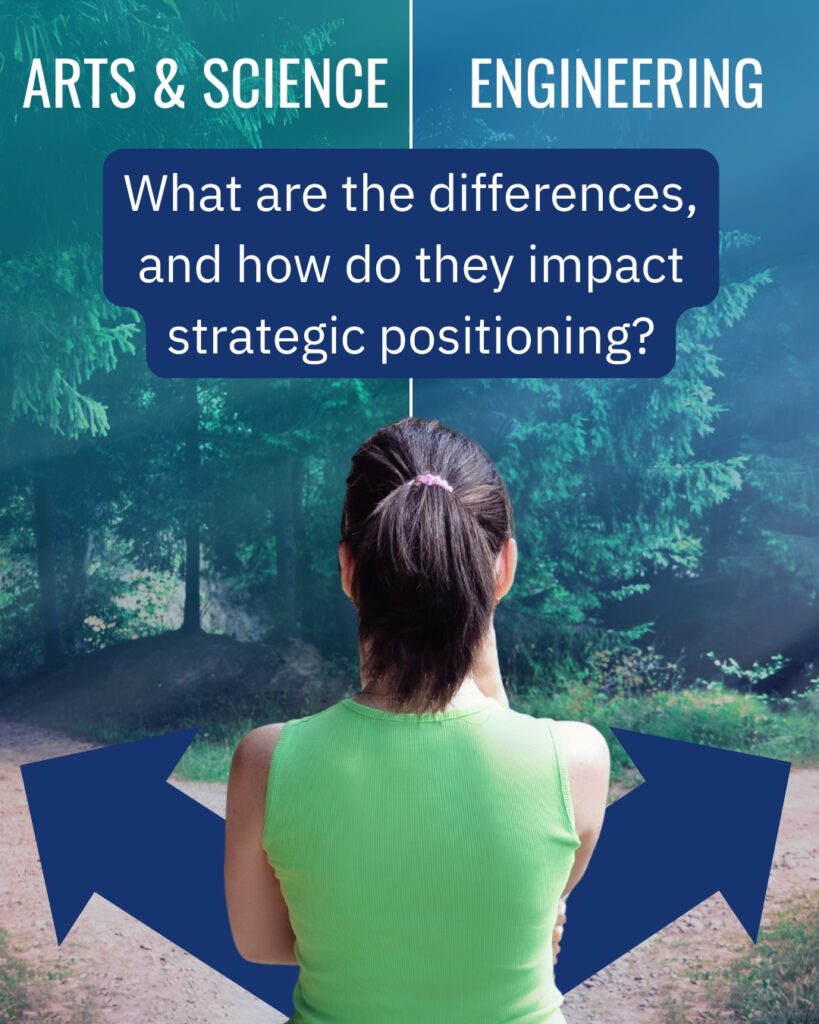(And How These Differences Impact Strategic Positioning)
Choosing between applying to an undergraduate program in Arts & Sciences (“Humanities”) or Engineering is one of the most important academic decisions a high school student will make in the college application process. While both paths offer rigorous educational experiences, they require distinct approaches in the application process and throughout college. Understanding these differences is crucial for students and their families, as the decision impacts course requirements, career trajectories, and even the ability to switch between majors.
At Solomon Admissions, our strategic positioning process considers the student’s ultimate goals for college, graduate school, and careers. We tailor our positioning approach and coaching plans to target the student’s ultimate goal in either Engineering or Humanities, recognizing that the profile needed for success varies considerably between the two pathways.

This is a crucial first step in the strategic positioning process. Understanding college admissions’ many intricacies can often be quite confusing, which is why Solomon Admissions provides expert advice on positioning, admissions trends, and tailored support. Schedule a consultation today to get started on your college process!
Understanding How Universities Separate Departments/Colleges
When applying to most universities, students typically choose a school (or college) within the larger university structure. Rather than applying to the university as a whole, they are actually applying to a specific academic segment within it. This does not apply to Liberal Arts Colleges (LACs), which do not create divisions between academic departments/programs.
Some examples of top universities’ undergraduate structures:
Duke University
Cornell University
- College of Agriculture and Life Sciences (CALS)
- College of Architecture, Art, and Planning (AAP)
- College of Engineering
- College of Human Ecology
- Cornell Jeb E. Brooks School of Public Policy
- Cornell SC Johnson College of Business
- School of Arts & Sciences (CAS)
- School of Industrial and Labor Relations (ILR)
University of Pennsylvania
- School of Arts & Sciences
- The Wharton School (Business)
- School of Engineering & Applied Science
- School of Nursing
Not all universities follow this model, though. Some, like Stanford University and Harvard University, do not require students to apply directly to a specific school or college within the university. Instead, students apply to the undergraduate program as a whole and have greater flexibility in choosing their major after they begin their studies.
What an Engineering Path Looks Like in College
Engineering programs follow a structured curriculum, requiring students to take technical coursework starting freshman year. Engineering degrees often demand more credit hours than A&S, limiting flexibility. Students typically declare their major by the end of freshman year.
Key aspects of an Engineering education include:
- A sequenced curriculum beginning with calculus, physics, and programming (e.g., Python, MATLAB).
- Labs and hands-on learning from sophomore year onward.
- Junior and senior years focus on advanced technical electives, research, and capstone design projects.
- Many students complete internships with companies like Google, Boeing, or Intel.
What an Arts & Sciences Path Looks Like in College
A&S programs offer broader academic flexibility. Unlike Engineering, students in A&S typically declare a major at the end of sophomore year, allowing time to explore disciplines. A&S programs require fewer credit hours, making double majors more common.
Key aspects of a Humanities education include:
- First and second-year students take general education courses (often called “general education requirements”) across humanities, social sciences, and natural sciences.
- Sophomore year involves exploring potential majors.
- Junior and senior years focus on advanced coursework, research, and capstone projects.
- Opportunities for interdisciplinary studies, double majors, and study abroad.

Challenges of Transferring into Engineering
Transferring from A&S to Engineering is difficult due to the structured nature of Engineering curricula. Students who start in A&S and later decide to switch often struggle to catch up on math and science prerequisites. For many top universities, transferring into Engineering is very difficult, so it’s important to prepare a strong Engineering profile with your Solomon Admissions consultant.
This is particularly true for schools such as the University of Michigan, the University of Texas at Austin, and the University of California—Berkeley, whose engineering colleges have strict transfer requirements, including completion of specific math and science courses with a competitive GPA. These are schools where you should apply directly to Engineering as a first-year applicant, rather than hope to transfer once you’re in freshman year.
In contrast, transferring from Engineering into Arts & Sciences is significantly easier with considerably fewer barriers. Also, because you generally declare your major at the end of sophomore year (in A&S), you’re not falling behind.
Career Pathways: MBA and Medical School Considerations
For students considering business or medical school, both Arts & Sciences and Engineering pathways are viable. Business schools seek diverse academic experiences, and both disciplines can prepare students well. That said, Engineering students may need to supplement their education with business-relevant coursework.
Medical schools accept students from various academic backgrounds, provided they complete required pre-med courses. Pre-med students in Engineering must carefully plan their coursework to fit in biology and chemistry prerequisites. However, A&S programs, especially in biological sciences, may be a more natural fit for pre-med students. Most universities have strong pre-med advising programs that help students from all academic disciplines prepare for medical school and secure the courses they need to apply to medical school.
Conclusion
Ultimately, the decision between Arts & Sciences and Engineering should be made with your Solomon Admissions consultant, with careful consideration of your interests, strengths, and long-term goals. Engineering requires a structured approach from day one, while Arts & Sciences offers more flexibility to explore different fields. Understanding these key differences ensures that you can make informed choices and position yourself for success in your undergraduate education and beyond.
We delve deep into this during our strategic positioning process, where we’ll focus on undersubscribed majors that give you the strongest possible angle for getting into your desired schools and cutting through the competitive, deeply saturated pool of applicants. Schedule a call with Solomon Admissions today!

Former Admissions Reader at Stanford University,
3 Years in Stanford University Admissions,
2,500+ Applications Read and Evaluated,
Peter Zimmerman is a Senior Admissions Consultant with Solomon. Peter earned his Bachelor’s Degree from The College of William and Mary in Art/Art History, with minors in Anthropology and Japanese Studies.
He graduated summa cum laude and was inducted into Phi Beta Kappa – the United States’ oldest honor society for liberal arts colleges. Mr. Zimmerman was one of the first students ever to receive W&M’s prestigious 1693 Scholarship — one of the most distinguished scholarship programs in the country, emphasizing student-led research and academic excellence. In addition, he was awarded W&M’s Martha Wren Briggs Scholarship for academic distinction in Art History. He also attended the Tuck School of Business at Dartmouth.



